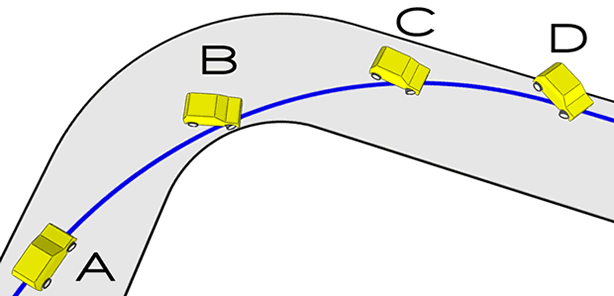Over-steering occurs when the rear tires reach the limit of adhesion in a corner before the front. This leads to ‘the back coming out’. Technically speaking, over-steering means that a car’s rear tires are operating at a greater slip angle than the front tires, i.e., they’re working harder. In real-world terms, it means the tail of?the car is sliding sideways. Holding the car in this dynamic state results in a glorious drift. Failing to hold it usually ends with an inglorious spin. Controlling over-steering in a rear-drive car is all about separately regulating the lateral velocity at each end of the vehicle.
Over-steering – factors involved
Over-steering results from a number of factors, some of which involve the natural handling characteristics of the car, and some result from the way it’s being driven.
Passive factors at work (the natural properties of the car):
Weight distribution (front or rear bias)
Engine and drive layout
Suspension & chassis setup
Tire type, wear and pressures
Active factors involved (the way it’s being driven):
Cornering speed
Throttle
Braking
Steering inputs
Weight transfer
Symptoms
It’s unlikely you’ll ever experience over-steering unless you’re driving a car near the limits of grip. You can recognize over-steering if…
The rear of the vehicle becomes unstable and ‘light’ due to lack of grip
The car starts to rotate so the driver is facing towards the inside of the corner
Causes
There are four major active causes of over-steering, but what you’re likely to encounter depends on the car being driven. Causes include:
Entering the corner too fast
Accelerating into the corner, too early or too aggressively
Braking into the corner or mid corner
Lifting off the throttle mid-corner. This scenario is also known as:
Lift-off over-steering
Snap over-steering
Trailing-throttle over-steering
Throttle-off over-steering
Lift-throttle over-steering
Preventing & correcting over-steering – rules of thumb
To correct any form of traction loss, you need to consider why you’ve exceeded the limits of grip at the wheels. In all cases of over-steering, counter steering is also required (explained here).
1. Entering the corner too fast
Enter a corner too fast and you’re asking for trouble. Unless of course you have a lovely long run off to play with or if you’re driving Silverstone in a go-kart. It’s not the quickest way to take a corner and leads to increased risk of over-steering. If you have entered a corner too fast, ensure that every input you make is incredibly smooth, and take the easiest route. Next time make sure your entry speed is slow enough to maintain grip, you can build up speed as you gain experience.
2. Accelerating into the corner, too early or too aggressively
If you manage to break traction at the back when applying throttle, you’re probably in a powerful car and need to be less aggressive. If you’re spinning wheels, the power is not transferring to the road and you’re not benefiting from the many horses you have sitting under the bonnet. Gently ease off the gas and you should regain adhesion at the rear wheels.
3. Lifting off the throttle mid-corner
If you are on the power mid-corner and close to the limit, do not lift off the throttle. The resulting forward weight transfer can upset the balance of the car and allow the rear wheels to break loose. In a front wheel drive car, re-applying the throttle can often help in this situation.
4. Braking into the corner or mid corner
You should avoid braking in corners in most situations; however there are circumstances which require the use of the anchors. Ensure braking inputs are especially smooth, gentle and progressive, and if a squirrel has just run out in front of you, try steering around rather than doing an emergency stop. To correct brake-induced over-steering, smoothly (but rapidly) release the brake and adhesion should be reintroduced.
Correcting over-steering – counter steering / opposite lock
Whatever the cause of over-steering it is important to keep the front wheels pointing in the direction you’re hoping to go. If you fail to do this, the most likely result is a spin. This technique is known as counter-steering or applying opposite lock (see Diagram 3). You should apply enough steering lock to point the wheels in the direction of the slide as shown below. Too little and you’re likely to spin as the back continues to come round, too much and the car will rapidly over-correct, often resulting in a spin in the opposite direction. The skill can only be mastered with plenty of practice and should become instinct if you’re planning to drive fast on a track.
Tip: Always look and focus on the direction you’re hoping to go – this makes the steering correction almost automatic. Conversely – don’t concentrate too hard on that tree you’re hoping to miss as you will be more likely to head in that direction.
Applying corrective steering needs to be done rapidly to catch the back of the car before it slides to a point which may be difficult to control. Once the slide has been controlled and the back starts to fall back in line, it’s also important to get the steering correction off quickly too, otherwise you might find your-self with over-steering in the opposite direction due to the resulting pendulum effect.
Although you have done many preventive maintenance works, all car parts or systems will wear out eventually, car steering included. The problem may simple be caused by a bad steering component, or something more complicated. To identify, you can use the help of a professional diagnostic tool, like MaxiCheck Pro. It is specially designed to work on steering system. If you are looking for such a tool, you can browse our website and search your-self. You can browse our website www.autointhebox or simply click the product image below.

Getting rid of over-steering
by
Tags:
